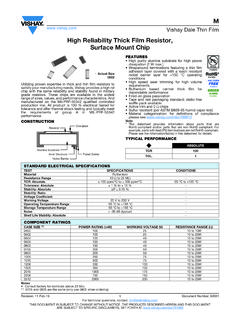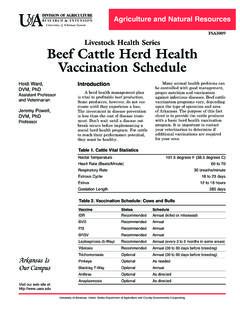Transcription of Fluid Fertilizers: Properties and Characteristics
1 Fluid fertilizers : Properties and CharacteristicsDale F. LeikamFluid Fertilizer December 8, 2010 8:00 8:158:159:009:009:459:4510:10 Session ASession B10:1011:00 Operation Issues/Maintenance (C. Schultze)Basic Fluid Characteristics , Salt-out, Solubility, Etc. (D. Leikam)11:0011:50 Storage Tank Inspection, Maintenance & Failure (C. Brooks)Use of VRT Programs In Dealer Research (M. Wiebers)11:501:00 LunchLunch1:001:50 DOT Rail Tank Car Certification (M. Orr)Urea Volatilization: How Large Is The Issue and Losses (D. Kissel)1:502:40 New Technologies: Products and Additives (D. Leikam)2:403:30 Statistics: How They Are Used and Mis-used (S. Staggenborg)3:303:503:504:40 UAN Management: Corrosion, Composition, etc (R. Satterfield)Fertigation: Equipment and Agronomics (J. Schepers)4:405:30 Formulation Issues At The Plant (M. Orr) Fluid Starter Fertilizer Sources ( Zabel)6:007:30 Thursday, December 9, 20108:008:108:109:00 Session ASession B9:109:50 Micronutrient Compatibilities (A.)
2 Robinett)High Yield Systems; Fertility Programs For the Future (M. Alley)9:5010:1010:1011:00 Regulatory Update and Other Issues. (J. Payne)Five Factors To Improve The Odds For High Yields (M. Bauer)11:0011:50 Fluid Storage and Shelf Life Issues (J. Walker and Panel)High Yield Systems: Role of Placement and Timing (S. Murrell)11:5012:00 - - - - - - - - - - - - Break - - - - - - - - - - - - - - - - - - Wrap-Up, Thank You, Have a safe trip home!! - - - - - - - - Welcome and Announcements - - - - - - - - Fluid Fertilizer Solutions and Opportunities (D. Fairchild ) - - - - - - - - National/Global Fertilizer Outlook and Trends (T. Erny) - - - - - - - - - - - - - - Break - - - - - - - - - - - - - - - - - - - - What's New In Washington?
3 TFI Update (F. West) - - - - - - - - - - - - - - - - - - - - Social Time / Reception - - - - - - - - - - - - - - - - - - - - - - - - Break - - - - - - - - - - - - - - - - - - - - - - - Announcements, Housekeeping - - - - - - - - - - - - Indianapolis Marriott EastFluid fertilizers Increasing in popularity in and elsewhere Advantages include Flexibility and versatility in application Efficiency and adaptability Benefits of continuous bands Ease of handling Does not segregate Flexibility, etc. Limitations Often higher purchase price than solid fertilizers ** Salt-out and precipitate formation potential with certain products and blendsUAN + 51,000 Tons N/year USA fertilizer market share by source: Commercial fertilizers , AAPFCO & TFIy = + -53654R = share, %Dry *Ammonia *Excludes dir.
4 Appl. anhydrous ammoniaFluid fertilizers Terminology, Solubility, Density and N Solutions Solution All salts totally dissolved in water. No solids allowed!Slurry Fluid product containing water, dissolved salts andundissolved salts. Settles out quickly. Not Fluid product containing water, dissolved salts, fine undissolved salt crystals and a suspending agent normally attapulgite Water Solutions with undissolved solids or suspensions containing too few undissolved salt crystals. Not a good range to try and operate in!!. Falling Out Of Solution No such Crystals form as solution cools; goes back in solution as product is warmed. Example; UAN Formation Non-crystalline mass forms which has much lower solubility than original ingredients in solution. Example; Improperly stored Fluid phosphatesUrea Solutions0102030405060708002468101214161 8202224 Percent NSalt-Out (F) (Lb/Gal)Salt Out (F) Nitrate Solutions0102030405060708090024681012141 618202224 Percent NSalt-Out (F) (Lb/Gal)Salt Out (F) Make 32-0-0 UAN Solution How Much Water Is Needed ?
5 ABCE utectic Point point of maximum solubility32% UAN contains: approximately 35% ammonium nitrate, 45% urea and 20% water at eutectic point28% UANcontains 30% waterUrea - Ammonium Nitrate Solutions(32 degree F saltout)010203040506070809010040:040:104 0:2038:3037:4035:4530:4620:4810:510:53 Urea - Ammonium Nitrate Ration% Material1416182022242628303234% NAmm. NitrateUrea% NTo Make 32-0-0 UAN Solution How Much Water Is Needed ?ABC20% WATERUrea - Ammonium Nitrate Solutions-20-100102030405060048121620242 832 Percent NSalt-Out (F) (Lb/Gal)Salt Out (F) SolutionsAmm. Nitrate14 F14 F-4 F32 F50 F68 F86 F-16 F100 % Amm. 100%Urea 100%10%20%30%40%50%60%70%80%90%10%20%30% 40%50%60%70%80%90%10%20%30%40%50%60%70%8 0%90%UAN Solution Salt-out is an issue in many environments There is very little water in UAN solution. Warm water has ability to dissolve more salts than cold water Salt-out occurs when salt content exceeds solubility at a given product temperature Crystals form on tank walls as temperature cools Eventually salts accumulate at tank bottom Salts will re-dissolve with sufficient heat and recirculationLowering Water Freezing Temperature With UAN SolutionFreezingTemperature F% N28-0-032-0-0gal per 100 gal Phosphate Products Fluid Phosphate Products and Characteristics Phosphoric AcidWet-Process Acid Black, brown, green (calcined) Contains many rock impurities Used in fertilizer industryFurnace, food-grade acid Clear No impurities Food and industrial processesOrthophosphoric Acid ExamplesSourceP2O5 MgOFe2O3Al2O3 FSolidsVisc.
6 @100FP/FAcid : Texas GulfAmmonium Polyphosphate Primary P source for much of Fluid industry Many NPKS products made from APP Produced from ammonia, superphosphoric acid and water Generally equal agronomic performance as compared to solid fertilizers If applied at equal P rates in similar manner Potentially superior to solids if discontinuous bands result from with solid fertilizer band applications Contains most P as polyphosphateHeat links phosphates by removing chemically bound waterHeat comes from chemical reaction of reacting phosphoric acid with ammonia=HOPOHOOH====HOPOHOOH====HOPOHOOH ====HOPOHOOH====HOPOHOOH====HOPOHOOH==== HOPOHOOH====HOPOHOOH===H2OH2OH2O=HOPOOH= ===OPOOH====OPOOH====OPOHOOH===OrthoPyro TriHigherFlow Diagram For Ammonium Polyphosphate Production10-34-0 & 11-37-0 Why Do We Want Polyphosphates ? Not necessarily for agronomic reasons Manage sludge problems in Fluid P products Polyphosphates sequester metal cation impurities in the product (especially Mg) to form relatively insoluble precipitates Provides superior storage qualities Increased analysis compared to orthophosphate Provides ability to include higher amounts of micronutrients in product (notCa or Mg)Hydrolysis Of Polyphosphate To Orthophosphate24 Hour PolyphosphateSoil TemperatureHydrolysis (%)41 F30-40 %68 F50-60 %95 F80-90 %Chang and Racz, 1977 After application to soils, polyphosphate is quickly converted to orthophosphate by abundant soil enzymesPlants utilize orthophosphatesEffect of Poly Content and N:P2O5 Ratio On Total N + P2O5 Content354947454341393770% Poly45% Poly0% PolyN:P2O5 Weight RatioWhy Do We Want Polyphosphates ?
7 Not necessarily for agronomic reasons Manage sludge problems in Fluid P products Polyphosphates sequester metal cation impurities in the product (especially Mg) to form relatively insoluble precipitates Provides superior storage qualities Increased analysis compared to orthophosphate Provides ability to include higher amounts of micronutrients in product (notCa++or Mg++)15 F50 F75 F110 FSource: Farmland IndustriesFactors Impacting Precipitate Formation In Storage Amount of polyphosphate initially present Amount of impurities in super-acid Other impurities added to product Zinc Previous product sludge Temperature of stored product Length of time product storedAPP Storage and Housekeeping Suggestions Do not store longer than necessary Avoid storage in summer months Completely empty and clean tanks regularly Know the quality of remaining product before adding additional product to tanks Do not contaminate with products/impurities that may affect storage Properties Never mingle any calcium or magnesium with product or mix plant Make sure that farmers and dealers lines, tanks and equipment are completely cleaned after use Final maximum grade May Contain 31 Total Plant Food Units.
8 N = 25% of 31 = .25 X 31 = N P2O5 = 50% of 31 = .50 X 31 = P2O5 K2O = 25% of 31 = .25 X 31 = K2O100 % K2OP2O5 100%K2ON 100%10%20%30%40%50%60%70%80%90%10%20%30% 40%50%60%70%80%90%10%20%30%40%50%60%70%8 0%90%15151717192123252729313335394143453 7474970 % Poly15N:P2O5:K2O RatioSolution Analysis(32F Saltout)Solution Grades For UAN Solution (28-32% N), Potassium Chloride (0-0-62) and Ammonium Polyphosphate (10-34-0, 11-37-0) SystemN:P2O5:K2O RatioSolution Analysis(32F Saltout)Typical Characteristics Of Several Fluid Fertilizer ProductsSourceAnalysisDensitySalt-OutGen eral CommentsN-P2O5-K2 OLbs/gal ~ 30% -32~ 20% <20 Fluid S Source of <1011-37-0 grade alsoTemperature Effect On Fluid fertilizers d De nsity (lb/gal)Product - - - lb / gal - - - Estimated Density Of Fluid Products Salt-out Crystals form as solution cools; goes back in solution as product is warmed.
9 Example; UAN formation Non-crystalline mass forms which has much lower solubility than original ingredients in solution. Example; Improperly stored Fluid phosphatesHeat generator Generates chemical heat when producing solutions. Examples; ammonia + phosphoric acid; dilution of sulfuric acid)Fume generator Generates fumes which can be safety hazard. Example; UAN solution + Potassium carbonate ammonia + K2CO3 2 KNO3+ (NH4)2CO32NH3+ H2CO3H2O + CO2 UAN in Irrigation Water ?UAN in Irrigation Water ?Urea N Volatilization ?2NH4NO3+ CaCO3 Ca(NO3)2+ (NH4)2CO32NH3+ H2CO3H2O + CO2 Caution: This chart contains information based on the opinions of people in the Fluid fertilizer industry. This information has beencompiled as a general guide only. Neither the Fluid Fertilizer Foundation or contributors guarantee the accuracy of the information. Please refer to manufacturer/supplier product information and alsoPerform a small jar compatibility test prior to final mixing.
10 'Compatible', results in relatively stable 'Limited Compatibility', generally compatible within solubility limits.'Very Limitied Compatibility', generally unsuitable Ammonia 'Incompatible', unsuitable mixture and/or hazardous Ammonia; 20-0-0 Significant heat Soln; 23-0-0 Ammonium Nitrate Soln; 20-0-0 Urea Ammonium Nitrate Soln; UAN 28/32-0-0 Ammonium Sulfate Soln; 8-0-0-9S Ammonium Polyphosphate Soln; 10-34-0 Ammonium Chloride Soln; 6-0-0-16Cl Ammonium Thiosulfate Soln; 12-0-0 26S Potassium Thiosulfate; KTS 0-0-25-17S Calcium Thiosulfate; CaTS, 6%Ca 10%S ?Magnesium Thiosulfate; MgTS, 10%S 4%Mg ?`Calcium-Ammonium Nitrate Soln; 17-0-0 Calcium Nitrate Soln; 9% N, 11% Ca ?Potassium Carbonate Soln; 0-0-32 ?N-pHuric 28/27; 28-0-0 9S N-pHuric 15/49; 15-0-0 16S N-pHuric 10/55; 10-0-0 18S Water ```Nitric Acid Phosphoric Acid (white) Phosphoric Acid (green) Sulfuric Acid Urea; 46-0-0 Ammonium Nitrate; 34-0-0 DryCalcium Nitrate; DryDryPotassium Chloride; 0-0-62 DryDryDryPotassium Nitrate; 13-0-46 ?







